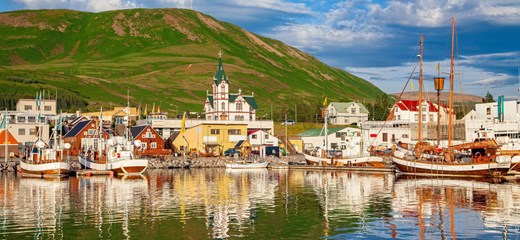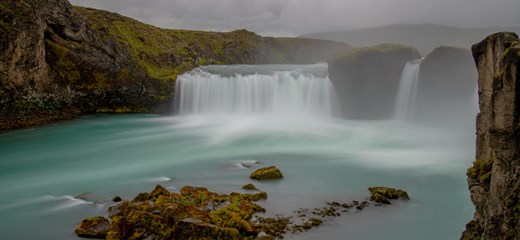
Diving in Iceland: Discover the Best Scuba Diving Spots
Go to chapter
- 1. Silfra Fissure. Thingvellir: Dive Between Continents
- 2. Strytan, North Iceland: Dive with Hydrothermal Vents
- 3. Kleifarvatn Lake, Reykjanes: Explore Geothermal Springs
- 4. Garður, Reykjanes: Exploring Marine Life in the Ocean
- 5. SS El Grillo, Seyðisfjörður: Exploring a Sunken Wreck
- Additional Information About Diving in Iceland:
The Best Dive Sites in Iceland
Iceland is a country offers a unique and thrilling experience for scuba diving enthusiasts. From diving between tectonic plates to exploring hydrothermal vents and geothermal springs, the dive sites in Iceland are unlike any other in the world.
Here, we’re going to cover the best scuba diving spots in Iceland, providing you with all the information you need to add them into your next campervan adventure in Iceland.
1. Silfra Fissure. Thingvellir: Dive Between Continents
One of the most famous dive sites in Iceland is the Silfra fissure, located within the breathtaking Thingvellir National Park. Diving in Silfra offers a once-in-a-lifetime chance to venture underwater between the North American and Eurasian continental shelves. The water is clear, and in every direction, you’ll be able to admire the stark beauty of this unique underwater world.
Silfra is renowned for its incredible visibility, reaching up to 330 feet (100 meters) year-round. The water originates from the Langjökull glacier, traveling underground for an estimated 50 to 100 years before reaching the fissure. This journey gives the water its exceptional purity and a constant temperature of 35 to 39°F (2 to 4°C).
To dive in Silfra, drysuit certification is mandatory due to the cold-water temperatures. It is recommended to have experience of at least 20 dives before embarking on this extraordinary adventure. Whether you visit Silfra in the summer, with its long daylight hours, or in the quieter winter months, the unique experience of diving between continents will leave you in awe.
2. Strytan, North Iceland: Dive with Hydrothermal Vents
In the northern region of Iceland, you will find another remarkable dive site called Strytan. This site offers the rare opportunity to dive alongside a hydrothermal vent, a phenomenon usually found at great depths in the ocean. However, at Strytan, the vent rises from a depth of 196 feet (60 meters) to just 49 feet (15 meters) below the surface, allowing divers to witness its incredible beauty up close.
The geothermal cones of Strytan have been venting mineral-rich freshwater into the surrounding fjord for approximately 11,000 years. As a result, the vents have formed chimneys covered in vibrant marine life. During your dive, you may encounter curious wolffish, starfish, nudibranchs, clams, and large shoals of cod and pollock. If you're lucky, you might even spot a majestic humpback whale.
Diving in Strytan requires drysuit certification and good buoyancy skills. It is recommended to have at least 20 logged drysuit dives to fully enjoy this unique diving experience. The journey to the north of Iceland may be longer, but the sights and wonders of Strytan make it well worth the trip.
3. Kleifarvatn Lake, Reykjanes: Explore Geothermal Springs

Just 30 minutes south of Reykjavik, you will find Kleifarvatn Lake, offering a captivating dive into geothermal springs. The drive to the lake itself is a scenic adventure, with volcanic rocks reminiscent of a lunar landscape. As you enter the water, you'll follow a line on the lakebed that leads to a cratered area no deeper than 33 feet (10 meters).
While exploring Kleifarvatn Lake, you will witness continuous streams of bubbles and experience the unique smell of sulfur and hydrogen sulfide gases. The lakebed has a clay-like consistency, appearing scorched due to the release of hot gases. Deep craters with overhanging walls and bubbling gas add to the otherworldly atmosphere of this dive site.
Underwater, you may also encounter numerous dead brown trout, adding an eerie element to your dive. The movement of gas bubbles through the lakebed causes the surrounding rocks to vibrate, creating a truly unforgettable experience. Keep in mind that even in the summer, the lake's temperature can reach as high as 57°F (14°C), so diving in a drysuit is still recommended.
4. Garður, Reykjanes: Exploring Marine Life in the Ocean

Located near Keflavik International Airport, Garður offers an exceptional shore diving experience in the Atlantic Ocean. This dive site is characterized by its colorful algae, which function as a food source for a variety of marine animals. As you explore the kelp forests and rocky seabed, keep your eyes peeled for wolffish, flatfish, monkfish, scorpionfish, cod, pollock, and Atlantic herring.
Garður is also known for its potential encounters with larger marine species such as humpback whales, minke whales, and even orcas, sperm whales, fin whales, or blue whales. But sightings of these sea giants are less common. With a maximum depth of 60 feet (18 meters), Garður is suitable for divers with open-water certification, but drysuit qualification is preferred.
5. SS El Grillo, Seyðisfjörður: Exploring a Sunken Wreck

For history enthusiasts, the SS El Grillo wreck dive in Seyðisfjörður on the east coast of Iceland offers a fascinating underwater exploration. This British oil tanker was sunk by German fighter planes during World War II. The wreck lies at a maximum depth of 148 feet (45 meters), with the highest point at 92 feet (28 meters).
Diving the SS El Grillo allows you to witness the remnants of this historic event and explore the ship's structure. The dive requires advanced certification, and nitrox is preferable due to the depth. As with other dive sites in Iceland, drysuit certification is necessary. The best time to dive the wreck is between May and September when the weather conditions are more favorable.
Additional Information About Diving in Iceland:
Iceland's dive sites offer an utterly unique and unforgettable experience for scuba diving enthusiasts. From diving between tectonic plates in Silfra to exploring hydrothermal vents in Strytan, Iceland's underwater world is full of wonders.
Whether you choose to dive in the clear waters of Silfra or explore the marine life in the ocean at Garður, you’re going to have a fantastic time. But remember to always dive with certified dive operators and follow proper safety procedures when exploring Iceland’s dive sites.
Also note:
- Diving in Iceland requires drysuit certification due to the cold-water temperatures.
- The best time to visit Iceland for diving is between April and October, with the warmest temperatures in August.
- Iceland's dive sites offer excellent visibility, with Silfra boasting up to 330 feet (100 meters) of visibility year-round.
- Several dive operators such as DIVE.IS and Magmadive offer guided dives and certifications for diving in Iceland.
Related articles

What to See, Do and Eat in Akureyri: Iceland’s Capital of the North
Wondering what there is to do in Akureyri in Iceland? Find out the best things to see and do in Akureyri whether it’s winter or summer.
Read more
The 10 Best Things to See and Do in North Iceland
From hot springs to whale watching, this article discovers the 10 best things to see and do in North Iceland.
Read more
The 10 Best Campsites in Iceland
One of the best ways to soak up the stunning Icelandic nature is through a campervan trip. Here are the best campsites in Iceland.
Read more James Taylor
James Taylor






